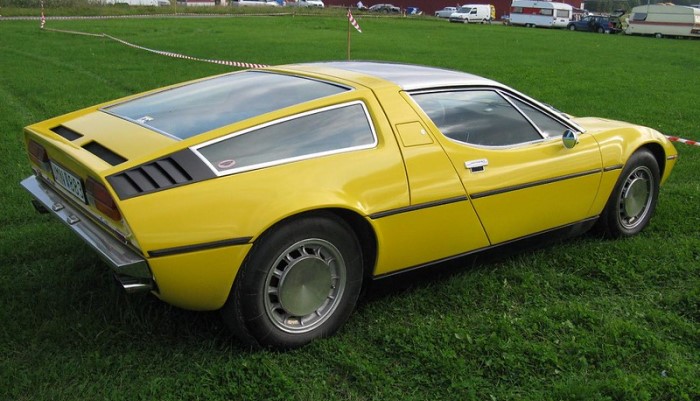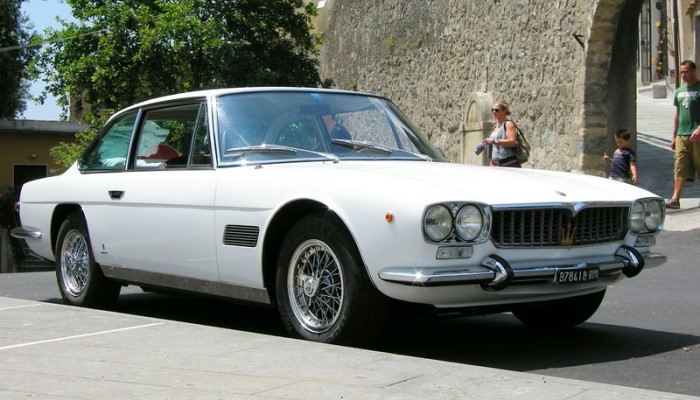Maserati Bora

Photo: "Maserati Bora" by nakhon100
Important Milestone for Italian Company
For Maserati, the Bora was an important milestone. For the first time, the engine took a central position, and the rear suspension received an independent double wishbone design. And Giugiaro created it for Maserati.
By 1971, almost all famous designers had signed their autographs on cars from Modena: from Pininfarina, which built that very first A6, to Vignale with its Sebring and Mexico. Having created the ItalDesign company in 1969, Giugiaro became Bora's personal couturier.
Many years later, Giorgetto recalled how, in 1966, when he was still working for Ghia, a visiting muse forced him to throw out several sketches on paper at once. The fruits of inspiration soon became De Tomaso Mangusta and a little later Maserati Bora.
Visual Identity
At first glance, the car seems moderately aggressive. The body turned out to be surprisingly rigid, unlike other GTs of those years—Giulio Alfieri had already tried this.
Up to the B-pillar, it is a load-bearing steel monocoque; at the rear, a welded tubular frame is integrated into it, on which the engine, rear suspension arms, and gearbox rest. This solution made it possible to avoid excess weight (the vehicle weighs no more than 1.5 tons) and, at the same time, left freedom for subsequent body transformations.
The style of the Maserati Bora has become a classic of the 1970s. Take a look at the sweeping, choppy lines of its body. The door received a deep bevel forward, as if following the contour of the seat. On the powerful middle pillar, there is a gas tank filler hatch with a miniature lock.

Photo: "Maserati Bora" by nakhon100
Just behind the counter is a long, triangular piece of glass that extends all the way to the stern. The desire of the lines to converge at one point on the same "back of the head" is mercilessly stopped by the chopped-back part.
From then this "cut-off tail" can be seen on the Alfa Romeo Alfasud and Lancia Delta. Even the first generation Volkswagen Golf (Rabbit in USA) carries this signature element of the master.
At the rear, the Bora shows you simple lights, a modest chrome bumper strip, and four exposed exhaust pipes. At the front, the grille completely covers the radiator. Its pharynx is divided in the middle by an impressive "bridge of the nose" and is decorated with the signature Maserati trident.

Photo: "Maserati Bora" by nakhon100
The retractable headlights hidden in the engine compartment are duplicated by a pair of powerful fog lights. This helps avoid the disharmony that occurs when using the main light.
Interior
The seriousness of the intentions is also felt inside the car. The seats look a little unusual, reminiscent of hammocks in a psychological relief room. Bora owners noted that they found an unexpectedly spacious cabin for a car of this configuration, and visibility from the driver’s seat could surprise even a picky racer.
In general, the interior is designed in a true Italian spirit; there is as much leather as there is plastic in modern cars. Along with the seats and door panels, the impressively sized dashboard, the tunnel between the seats, and the wall separating the interior and the engine compartment are covered in leather.

Photo: "File:Italian Concours Maserati Bora Interior (14818113917) (2).jpg" by James Bond
A similar approach to the concept of a sports car would be seen in later Maserati models, when ultra-powerful engines and almost racing suspension were accompanied by luxurious interiors. Sometimes the abundance of sparkling varnish on wooden parts and the shine of gilding on the bezel of a branded watch make you forget about the origin of the car.
By the way, about the famous Maserati watches: on the Bora model, they are still unremarkable—a black circle among the same type of "pressure and temperature" indicators. The latter had to do their job clearly: monitor the main organ of Bora, its engine.
Specifications
This beauty boasted impressive performance figures, with the 288 cid (4.7 L) engine producing 310 HP and the 301 cid (4.9 L) engine producing 330 HP. This allowed acceleration from 0 to 60 mph (96 kph) in around 6 seconds and reach a top speed of 169 mph (271 kph).

Photo: "Maserati Bora" by smaedli
Engine Specs
| Engine Type | V8 |
| Layout | Middle engine, RWD |
| Displacement | 301 cid (4930 cc) |
| Power | 330 hp |
| Power/Weight | 190 hp / Tone |
Performance
| 0-60mph (0-96kph) | 6,2 s |
| 0-100mph (0-160kph) | 14,6 s |
| 300 meters | 12,7 s |
| Top Speed | 169 mph (271 kph) |
In terms of handling, the Maserati Bora featured a mid-engine layout, which helped to distribute weight evenly and improve overall balance on the road. The car also came equipped with advanced features for its time, such as power-assisted steering and four-wheel disc brakes.
Maserati Bora in Today's Market
This classic Italian sports car is a true beauty, blending performance and sophistication in a way that only Maserati can. Sure, you could opt for a boring sedan or a run-of-the-mill SUV, but why not treat yourself to something special? The Maserati Bora is sure to make you feel like a million bucks, even if your bank account doesn't quite match up.
With its distinctive pop-up headlights, curvaceous body, and powerful engine, the Maserati Bora is a true showstopper. You'll feel like a celebrity every time you step behind the wheel, even if you're just running errands or sitting in traffic. And let's be honest, who doesn't want to feel like a rockstar every now and then?
The current price range for a well-maintained Maserati Bora ranges from $75,000 to $350,000, depending on various factors such as mileage, condition, and rareness of the model. Well, it's not exactly a budget-friendly option, but hey, you can't put a price on happiness, right? Treat yourself to the car of your dreams and watch as your neighbors turn green with envy.
So what are you waiting for? Head to your local Maserati dealership and test drive a Bora today. Just be prepared to fall in love at first sight – this beauty is hard to resist!

Unique Car Zone Team
A group of several fans of everything that moves on four wheels, a few article creators, a couple of marketing strategists, designers, web developers, and lots of coffee.






